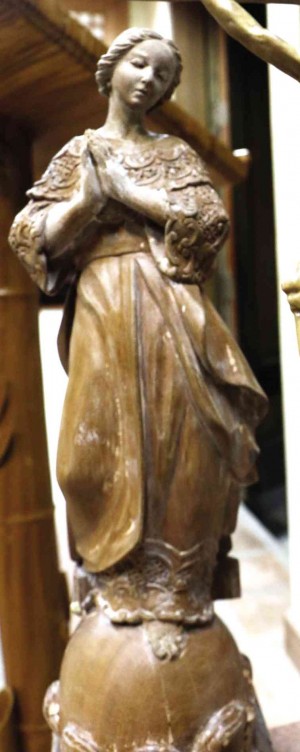Love for Francis turns wood into rare gifts

THE 19-INCH image of the Immaculate Conception which artist Wilfredo Layug sculpted from a piece of wood that used to form part of the trusses of the Palo Metropolitan Cathedral which was blown off by Supertyphoon “Yolanda.” E.I. REYMOND T. OREJAS/ INQUIRER CENTRAL LUZON
GUAGUA, Pampanga—In the wood carving village of Sta. Ursula in the old district of Betis on Tuesday morning, workers from the Archdiocese of Palo carefully loaded onto a truck a 5-foot-tall image of the Nuestra Señora de Salvacion.
From Pampanga province, the statue was taken to Villamor Air Base in Pasay City from where it was flown by a C-130 plane to Tacloban City, and then to nearby Palo in Leyte province.
This Marian image—its face a combination of the Mother of Perpetual Help and the Our Lady of Sorrows—will be paired with the Sto. Niño de Tacloban for the Mass that will be led by Pope Francis with victims of Supertyphoon “Yolanda” at the Tacloban airport on Jan. 17.
Before noon, another set of workers arrived and hauled a 10-foot-tall crucifix, a lectern, two small crosses and a processional cross to be used for the papal Mass at Quirino Grandstand in Manila on Jan. 18.
Villagers had milled around the workshop of Wilfredo Layug, marveling at the sculptures for the visit of Francis. Some touched or kissed the images, perhaps moved by the emotions portrayed by these or the significance they attached to the Pope.
Article continues after this advertisementArticle continues after this advertisement
Labor of love
Not one of the six images was commissioned, said Layug, a presidential merit awardee for the ecclesiastical art. “No money is involved. It’s a labor of love for a once-in-a-lifetime event,” Layug, 55, told the Inquirer.
Except for the Marian image and the processional cross, the rest of the images would be returned to Layug after the papal visit.
He intends to put them in a museum to preserve and sustain wood carving in Betis, one of the oldest towns in Pampanga that Augustinian friars converted into Catholic missions beginning 1572.
Layug, a son of a boat carver, began carving at the age of 14.
For the 1981 visit of St. John Paul II for the beatification of San Lorenzo Ruiz, he made a bust of the first Filipino saint. For the World Youth Day that St. John Paul II led in the Philippines in 1995, Layug made the retablo (niches of saints) of Sto. Niño de Tondo Church in Tondo, Manila.
Gift to Francis
A seventh image is his gift to Pope Francis—a 19-inch statue of the Immaculate Conception that he carved out of a piece of Yolanda debris, a yakal, that used to belong to the trusses of the Palo Metropolitan Cathedral.
The 10-foot-tall cross features a crucified Jesus Christ that is 5 feet and 10 inches tall. The cross is made out of pine that was imported from Canada while the image of Christ is made out of gmelina. It will be part of the backdrop at the Mass at the grandstand.
The lectern, made of teak wood designed like a bamboo, is where the Pope will give his homily.
The two small crucifixes are made of teak wood and gmelina, both for the altar tables at the papal Masses at Manila Cathedral and Quirino Grandstand.
The processional cross, made of gmelina, will become property of the Archdiocese of Manila.
The Marian image wears a Filipiniana dress with shawl done in “estofado,” a style that makes it like it was embroidered by hand. The Virgin Mary, with sadness etched on her face, holds a boy by her waist. This boy reaches out to another boy by extending the rosary to the latter. She stands on a globe with violent waves as base.